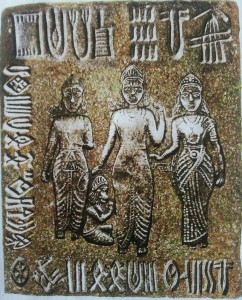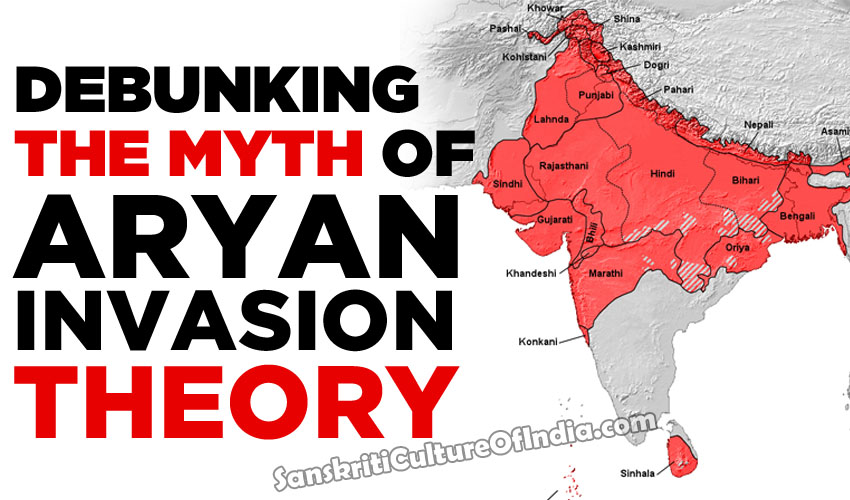The Aryan Invasion Theory is not a subject of academic interest only, rather it conditions our perception of India’s historical evolution, the sources of her ancient glorious heritage and indigenous socio-economic-political institutions which have been developed over the millennium. Consequently, the validity or invalidity of this theory has an obvious and strong bearing on the contemporary Indian political and social landscape and the future of Indian nationalism.
The Aryan Invasion Theory (AIT) denies the indigenous origin and evolution of the sources of India’s glorious Vedic culture and heritage. Such a proposition defies common sense and available scriptural, archaeological and historical evidence. For thousands of years Hindu society has looked upon theVedas as the fountainhead of all knowledge–spiritual and secular–and the mainstay of Hindu culture, its heritage and existence. Never have our historical or religious records questioned this fact. And now, suddenly, in the last century or so, it has been propagated that the Vedas do not belong to Hindus, they were the creation of a barbaric horde of nomadic tribes who descended upon North India and destroyed an advanced indigenous civilization. A nomadic, barbaric horde of invaders cannot by any stretch of imagination produce the kind of sublime wisdom or pure and pristine spiritual experiences of the highest order as one finds in the Vedic literature.
AIT is merely a proposed “theory,” and not a factual event. Theories are modified, discredited, nay even rejected with the emergence of new knowledge and data pertaining to the subject matter of the theories. The most weird aspect of the AIT is that it has its origin not in any Indian record but in European politics and 19th century German nationalism. AIT has no support either in North Indian literature, tradition, science or in any of the South Indian, Dravidian (inhabitants of South India, who were supposed to be the victims of the so-called Aryan invasion) literature and tradition. There was absolutely no reference in Indian traditions and literature of an Aryan Invasion of Northern India until the British imperialists imposed this theory on an unsuspecting and gullible Indian society and introduced it to the Indian school curriculum.

A major flaw of the invasion theory was that it had no explanation for why Vedic literature that was assumed to go back into the second millennium BCE had no reference to any region outside of India. Also, the astronomical references in the Rig Veda allude to events in the third millennium bce and even earlier, indicating the origin of Vedic hymns earlier than 3000 BCE. The contributions of the Vedic world to philosophy, mathematics, logic, astronomy, medicine and other sciences provide one of the foundations upon which rests the common heritage of mankind. These are well recognized but cannot be reconciled if theVedaswere composed after 1500 bce.
Further, if it is assumed that the so-called Aryans invaded the townships in the Harappan valley and destroyed its habitants and their civilization, how come after doing that they did not occupy these towns? The excavations of these sites indicate that the townships were abandoned. And if the Harappan civilization was originated by the Dravidian, who were then allegedly pushed down to the south by Aryans, how come there is no Aryan-Dravidian divide in the respective literatures and historical tradition? The North and South of India have never been known to be culturally hostile to each other. Also, was South India uninhabited prior to the pushing of the original population of Indus Valley? If not, who were the original inhabitants of South India who accepted the newcomers without any hostility or fight?
If the Aryan Hindus were outsiders, why don’t they name places outside India as their most holy places or motherland? Why should they sing paeans in the praise of India’s numerous rivers crisscrossing the entire peninsula, and mountains–repositories of life giving water and natural resources, nay even bestow them a status of goddesses and gods. These are some of the obvious serious objections, inconsistencies and glaring anomalies for which the advocates of the invasion theory have no convincing or plausible explanations.
What, really, is the Aryan Invasion Theory?
According to this theory, northern India was invaded and conquered by nomadic, light-skinned RACE of a people called ‘ARYANS‘ who descended from Central Asia (or some unknown land ?) around 1500 BC, and destroyed an earlier and more advanced civilization of the people habited in the Indus Valley and imposed upon them their culture and language. These Indus Valley people were supposed to be either Dravidian, or AUSTRICS or nowadays Shudra class etc.
The main elements on which the entire structure of AIT has been built are: Arya is a racial group, their invasion, they were nomadic, light-skinned, their original home was outside India, their invasion occurred around 1500 BC, they destroyed an advanced civilization of Indus valley, etc. And what are the evidences AIT advocates present in support of all these wild conjectures:
- Invasion: Mention of Conflicts in Vedic literature, findings of skeletons at the excavated sites of Mohenjo-Daro and Harappa
- Nomadic, Light-skinned: Pure conjecture and misinterpretation of Vedic hymns.
- Non-Aryan/Dravidian Nature of Indus civilization: absence of horse, Shiva worshippers, chariots, racial differences, etc.
- Date of Invasion, 1500 BC: Arbitrary and speculative, in Mesopotamia and Iraq the presence of the people worshipping Vedic gods around 1700BC, Biblical chronology.
Consequences of the Aryan Invasion Theory in Context of India
- It serves to divide artificially India into a northern Aryan and southern Dravidian culture which were made hostile to each other by various interested parties: A major source of social tension in south Indian states.
- It gave an easy excuse to the Britishers to justify their conquest over India as well as validating the various conquests and mayhems of invading armies of religious fanatics from Arab lands and central Asia. The argument goes that they were doing only what Aryan ancestors of the Hindus had previously done millennia ago to the indigenous population.
- As a corollary, the theory makes Vedic culture later than and possibly derived from Middle Eastern cultures, especially the Greek culture: An absurd proposition.
- Since the identification of Christianity and the Middle Eastern cultures, the Hindu religion and Indian civilization are considered as a sidelight to the development of religion and civilization in the west: A deliberate and dishonest undermining of the antiquity and the greatness of the ancient Indian culture.
- It allows the science of India to be given a Greek basis, as any Vedic basis was largely disqualified by the primitive nature of the Vedic culture: In fact the opposite is true.
- If the theory of Aryan invasion and its proposed period were true, this discredited not only the Vedas but the genealogies of the Puranas, and all the kings mentioned in these scriptures including Lord Krishna, Rama, Buddha etc. would become as fictional characters with no historical basis: Which simply means disowning and discarding the very basis and raison de’etre of the Hindu civilization.
- The Mahabharat, instead of being a civil war of global proportion in which all the main kings of India participated as is described in the epic, would be dismissed as a local skirmish among petty princes that was later exaggerated by poets.
- In other words, the Aryan Invasion Theory invalidates and discredits the most Hindu traditions and almost all its vast and rich literary and civilization heritage. It turns its scriptures and sages into fantasies and exaggerations.
- On the basis of this theory, the propaganda by the Macaulayists was made that there was nothing great in the Hindu culture and their ancestors and sages. And most Hindus fell for this devious plan. It made Hindus feel ashamed of their culture – that its basis was neither historical nor scientific, the Vedas were the work of nomadic shepherds and not the divine revelations or eternal truth perceived by the rishis during their spiritual journey, and hence there is nothing to feel proud about India’s past, nothing to be proud of being Hindu.
In short such a view and this concocted Aryan Invasion theory by a few European historians in order to prove the supremacy of Christianity and Western civilization, served (and still serving) the purpose: ‘divide and conquer the Hindus‘.
Swami Vivekananda on Aryan Invasion Theory
“Our archaeologists’ dreams of India being full of dark-eyed aborigines, and the bright Aryans came from – the Lord knows where. According to some, they came from Central Tibet; others will have it that they came from Central Asia. There are patriotic Englishmen who think that the Aryans were all red haired. Others, according to their idea, think that they were all black-haired. If the writer happens to be a black-haired man, the Aryans were all black-haired. Of late, there was an attempt made to prove that the Aryans lived on Swiss lake. I should not be sorry if they had been all drowned there, theory and all. Some say now that they lived at the North Pole. Lord bless the Aryans and their habitations! As for as the truth of these theories, there is not one word in our scriptures, not one, to prove that the Aryans came from anywhere outside of India, and in ancient India was included Afghanistan. There it ends…”
“And the theory that the Shudra caste were all non-Aryans and they were a multitude, is equally illogical and irrational. It could not have been possible in those days that a few Aryans settled and lived there with a hundred thousand slaves at their command. The slaves would have eaten them up, made chutney of them in five minutes. The only explanation is to be found in the Mahabharat, which says that in the beginning of the Satya Yoga there was only one caste, the Brahmins, and then by differences of occupations they went on dividing themselves into different castes, and that is the only true and rational explanation that has been given. And in the coming Satya Yuga all other castes will have to go back to the same condition.” (The Complete Work of Swami Vivekananda, Vol.III Page 293.)
So, What are the facts?
Now, based on what has been presented above, following facts about an ancient and glorious period of India clearly emerge:
- The Aryan Invasion and Racial theories, and Aryan-Dravidian conflicts are a 19th century fabrication by some European scholar. They are being exploited even now for political reasons.
- The hymns of Rigveda had been composed and completed by 3700BC, this can be scientifically proved.
- The language of the Indus script is related to Sanskrit, the language of Vedas.
- The Indus valley civilization should be aptly called as Saraswati Vedic civilization, as the new evidences and right interpretation of the archaeological findings indicate.
- There is now strong evidence that the movement of the ancient Aryan people was from east to west, and this is how the European languages have strong association and origin in the Vedic Sanskrit language.
- The ending of Indus Valley and the Saraswati civilization was due to the constant floods and drought in the Indus area and the drying up of the Saraswati river. This had caused a massive emigration of the habitants to safer and interior areas of the Indian subcontinent and even towards the west.
- There was no destruction of the civilization in the Indus valley due to any invasion of any barbaric hordes.
- The Vedic literature has no mention of any invasion or destruction of a civilization.
- There is no evidence in any of the literature which indicate any Aryan-Dravidian or North-South divide, they were never culturally hostile to each other.
- The population living in the Indus valley and surrounding the dried up Saraswati river practiced the Vedic culture and religion.
~ Dr. Dinesh Agrawal is an Associate Professor of Materials Program, at Pennsylvania State University, USA.











